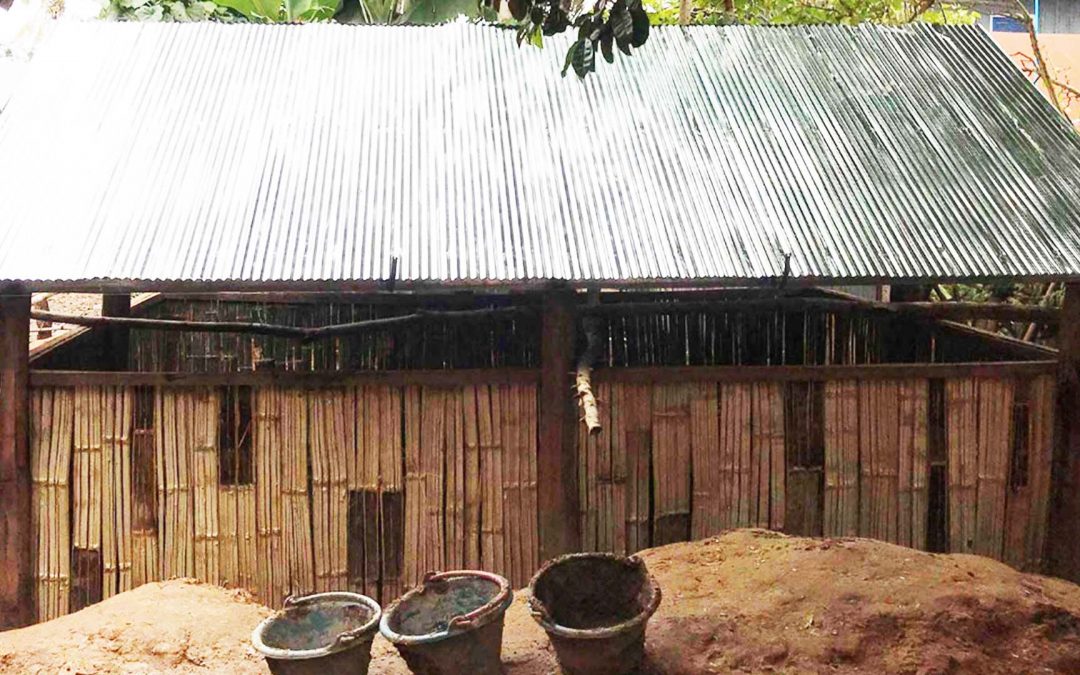- 4 EWB Field Professional volunteers placed with RWC since 2015
- Underground rainwater tank pilot tested in 10 households (57 individuals total)
- Over 20 RWC staff and interns capacity strengthened
Climate change has brought about significant drought and rain-scarcity is creating serious challenges in Cambodia.
The majority of families living in rural Cambodia cannot yet rely on piped water systems. Very often, the alternative water sources and supply systems are not safe. Surface water is contaminated, and springs and groundwater are not always easily accessible, or are unsuitable for human consumption due to contaminants such as arsenic.
According to Chray Pom, a Ministry of Rural Development director, half of Cambodia’s rural population—more than six million people—lack access to clean water. Within this general context, relying on sufficient rainwater as a safe source of water is crucial.
However, access to rainwater is increasingly challenged by recurrent drought brought on by climate change. There are also challenges such as unpredictability and delay in the arrival of rainfall in the early wet season, the total amount of rainfall, and the duration of the wet season.
In 2012, the Royal University of Phnom Penh undertook a study analysing social vulnerability to climate change in Kampong Speu Province. The study indicated that drought was the most severe hazard from 1999 to 2011 because it occurred in both lowland and upland areas of the province.
Among the 420 communities affected by drought in 2002, Kampong Speu province was the most severely—but not the only one—affected. Significant drought and rain scarcity has greatly reduced agricultural production, which in turn has affected food security. It has also had an impact on farmers’ livelihoods—negatively affecting health and reducing opportunities to generate income.
Significant drought does not solely affect farmers—it also has an impact on families, women and children. Results from the study showed that women were more vulnerable to extreme climate hazards due to their high workload and increased susceptibility to health problems, along with a lessened opportunity for education. The journey for women—who are mostly charged with collecting water—is far, hot, long and arduous.
With more rural communities demanding better systems to collect and store rainwater, Engineers Without Borders Australia (EWB) decided to partner with RainWater Cambodia (RWC) to explore the development of low-cost rainwater harvesting systems capable of storing significant volumes of water.
RWC, established in 2003, focuses on water, sanitation and hygiene improvement and has much experience in this sector. A key area of expertise for RWC is rainwater harvesting for households, schools and health clinics—making them a perfect partner for this project. EWB provides technical human-centred engineering support to the project.
In 2015 a team of local university students took part in the RainWater Cambodia Design Challenge, with the water challenge in Kampong Speu Province as their brief. It is one of many projects where EWB engages with Cambodian engineering students to develop their human-centred design approach, to provide practical experience in the development of real-world solutions. Not all ideas progress to development though. Rather, the process is designed to develop students’ skills. Sometimes, however, an idea emerges that is of particular interest, and that’s exactly what happened to some of the students who took part in this Challenge.
Based on an idea arising from the Cambodian Challenge program, EWB commissioned RWC to undertake a pilot project to design and construct underground rainwater tanks. The pilot aimed to determine how underground rainwater tanks could facilitate households to have year-round access to water for domestic use.
The system developed was based on traditional collection and storage methods combined with a modern risk-management approach, with the aim to provide a safe, sustainable water supply. Once the water supply for family needs is assured, additional methods for water collection can then be further explored for agricultural use.The underground rainwater tank uses local materials such as wood, bamboo, a hand pump and low-density polyethylene (LDPE) in its construction. The ability to access local materials and supplies is critical to the success of this project and to ensure the system is easily maintained into the future.
The pilot was successfully completed early in 2019 with the installation of two tanks. The families based where the tanks were installed are really satisfied with the system. The underground water tanks ensure the availability of safe water for a much longer period after the end of the rainy season than they have previously experienced.
Moving this solution forward, EWB and RWC are investing resources to conduct additional trials of the system in other drought-prone areas of Cambodia. As the technology utilised has proved to be successful, we are eager to progress the next phase of the trial, which is ensuring that the system is adopted and replicated on a larger scale in Cambodia.
Phase Two Underway
March 2020: Since the installation of the two tanks there has been testing to ascertain the long term viability of this solution. Testing needs to happens over a twelve month period to ensure the tanks are assessed in all climatic seasons. The feedback from the community was very positive, and as such we are about to commence Phase Two of this project.
The arrival of the dry season in Cambodia creates the right environment to commence building additional tanks, and we are working with other communities in Kratie, a new province for the project. For this phase, we will work alongside Rainwater Cambodia (for product knowledge) as well as Cambodia Rural Development Team (CRDT) – with whom we have just placed an Australian Volunteer Field Professional – to work directly with the community to build and monitor these new tanks. Construction will aim to be completed by May 2020 (before the rainy season starts).
This project receives support from the Australian Government through the Australian NGO Cooperation Program (ANCP) and from the Price Family Foundation.
You can also help build water storage solutions in Cambodia to give them water they’ll need during the next extended dry season. Please donate today.


